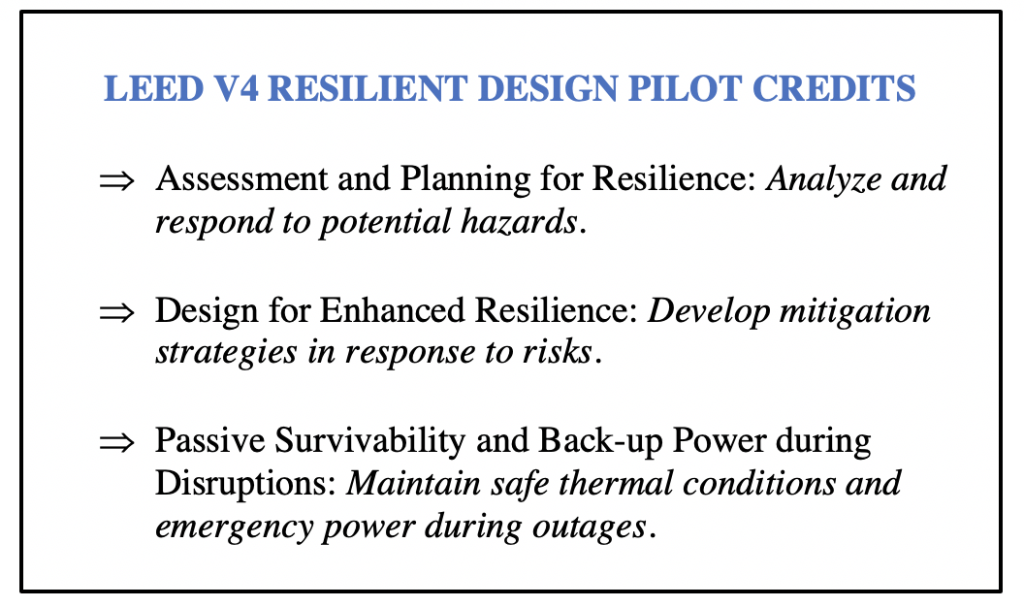Resiliency Lens
What is resiliency?
An increase in extreme weather events, increasing potential for grid-related failures, and associated health and safety risks, serves to focus attention on the importance of resilient building design. Resilient building design conveys an “ability to prepare and plan for, absorb, recover from, and more successfully adapt to adverse events.”[1]
The New Jersey Climate Change Alliance (NJCCA) identifies the following climate change threats to buildings in New Jersey:
“intense precipitation events and related flooding, wind, wave and storm surge flooding impacts from coastal storms up to and including structural failure, moisture penetration and associated degradation of building materials, higher incidence of mold and mildew, temperature extremes (both frequent high heat and extreme cold days) leading to material wear and failure, and utility failures from climate events as an indirect cause of material damage or failure.”[2]
Many strategies for increasing resilience in buildings are synergistic with existing green building objectives, such as an emphasis on daylighting, superior insulation values, thermal massing, and on-site renewable energy and water harvesting. These strategies reduce the need for electricity for lighting, cooling, and other critical functions, making buildings more resilient to power outages and disruptive events while also conserving energy.
In conceiving of the new resiliency emphasis of the Manual, the Rutgers Center for Green Building (RCGB) reviewed recent literature on resilient design by the USGBC Resiliency Working Group headed by Mary Ann Lazarus, FAIA and Alex Wilson, Director of the Resilient Design Institute, which developed the LEED Resilient Design pilot credits (see Figure 1).[3]

Figure 1 – LEED V4 Resilient Design Pilot (Credits. Source: USGBC)
RCGB also reviewed the RELi resilience rating system, including RELi Resilience Action List and Credit Catalog Pilot Version 1.2.1 developed by the Institute for Market Transformation to Sustainability (MTS) and its RELi Collaborative,[4] and RELi 2.0 Rating Guidelines for Resilient Design and Construction developed by the USGBC in partnership with MTS. Currently, in the pilot phase, RELi 2.0 provides a point-based, resilience rating and certification system for projects already pursuing LEED certification. Future versions of RELi aim to synthesize the RELi 2.0 Hazard Mitigation and Adaption Credits with the LEED Resilient Design pilot credits.[5]
The following list includes several categories and examples of green building and design strategies in the Manual, which also address increased precipitation and flooding issues, extreme temperatures, power outages, and compromised infrastructure and supply networks:
- Decision making tools and evaluation strategies for identifying and assessing cost-effective green and resilient building and design opportunities and alternatives (e.g., Integrated Design Process, Commissioning, Building Evaluation, Building Information Modeling (BIM), Energy Modeling, Life Cycle Assessment (LCA), and Life Cycle Cost Analysis (LCCA)).
- Green infrastructure strategies that mitigate environmental risks, such as increased precipitation and flooding issues, and utilize ecological-based technologies, which offer diversity and redundancy (e.g., Vegetated Roofs, Rain Gardens, Native and Adapted Plants, On-Site Alternative Water Reuse, Pervious Hardscape Materials).
- Passive cooling and heating strategies that reduce energy consumption and provide thermal comfort during heat waves, winter storms and power outages (e.g., Building Orientation, Cool Roofs, Daylighting, Energy-Efficient Landscaping, Glare and Heat Gain Reduction, Natural Ventilation, Insulation, Thermal Massing).
- Energy-efficient and renewable energy strategies that reduce peak demand, increase grid reliability, and support clean energy technologies (e.g., Combined Heat and Power (CHP), ENERGY STAR Equipment and Plug Load, High-Efficiency Water Heaters, On-Site Renewable Energy Systems, Properly-Sized HVAC Equipment, Thermal Energy Storage, Variable Frequency Drives).
- Smart building strategies that reduce stress on the electrical grid, support Demand Response Programs, smart grid infrastructure, and safety and security protocols (e.g., Demand Response and Peak-Load Management, Grid-interactive Efficient Buildings, Part-Load Efficiency, Smart Sensors and Controls, Smart Metering, Solar Islanding and Micro-Grid Ready Solar PV).
- Community-scale strategies that promote social interaction and build strong community ties increasing the ability of individuals, businesses, and communities to bounce back after adverse events (e.g., Alternative Transportation, Sustainable Materials).
- Indoor Environmental Quality strategies that increase occupant health and productivity and support one’s ability to cope with emergencies and disruptions (e.g., Active Living, Biophilic Design, Flexible WorkSpaces, Individual Comfort Controls, Moisture Control, Sustainable Materials, Views and Operable Windows).
The analysis further identified the need for a new category of strategies, “Back-up Systems,” which includes Energy Storage and Back-up Power Generation, and Emergency Water Supply and Storage. A strategy on Storm Preparation and Emergency Planning was added to prepare businesses and building occupants with tips and resources for common emergencies and natural disasters.
Finally, the 2019 update of the Manual introduces best practice strategies in green building that support resilient development in New Jersey. Research and understanding at the intersection of green building and resiliency is an evolving field and practice. The Manual aims to expand the focus of green building in New Jersey to include resiliency objectives while at the same time utilizing New Jersey’s recent storm history and climatic forecast to encourage more widespread adoption of quality green building practices, (which are inherently resilient) into mainstream practice.
For more information on resilient design, refer to the Resilient Design Institute and USGBC’s The Center for Resilience, which provides research, case studies, tools and resources on resiliency building initiatives including updates on the LEED Resilient Design Credits and the RELi resilience rating system.
[2] New Jersey Climate Adaptation Alliance (NJCAA). 2014. The Role of Buildings in Climate Adaptation. Climate Change Preparedness in New Jersey. Edited by Jennifer Senick.
[3] USGBC. 2019. Policy Brief: LEED Resilient Design Pilot Credits – How LEED Empowers Projects to Achieve a Higher Level of Resilience. https://www.usgbc.org/sites/default/files/LEED-Resilient-Design-Pilot-Credits-Brief-FINAL.pdf (accessed February 7, 2019).
[4] The RELi Collaborative is a network of professionals, experts, and graduate students at Perkins + Will; the C3 Living Design Project; the Capital Markets Partnership’s National Safety and Resiliency Committee; the American Institute of Architects Minnesota Committee on the Environment, the University of Minnesota School of Architecture; and the Upper Midwest hub of the American Institute of Architects Foundation National Resilience Initiative Network.
[5] U.S. Green Building Council, Inc. 2018. RELi 2.0 ating Guidelines for Resilient Design + Construction. December 20
